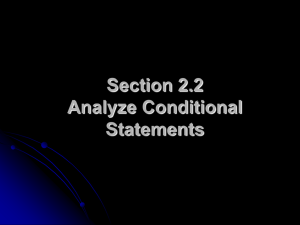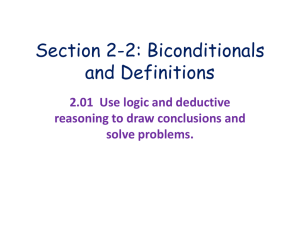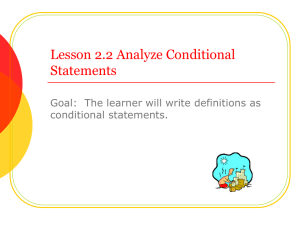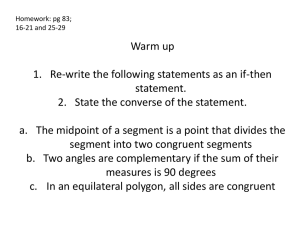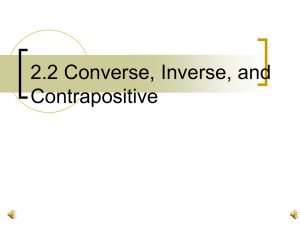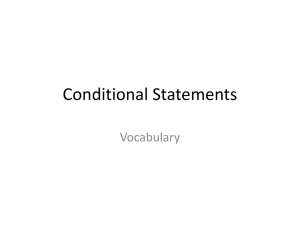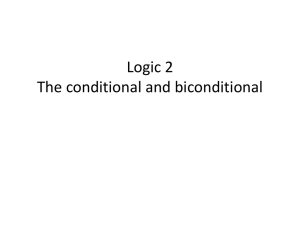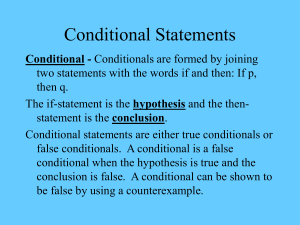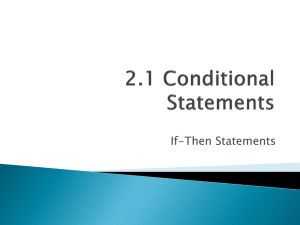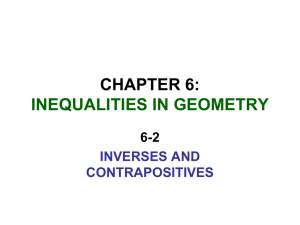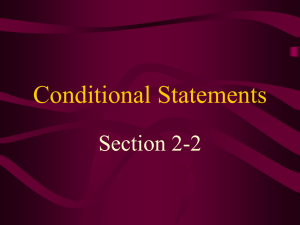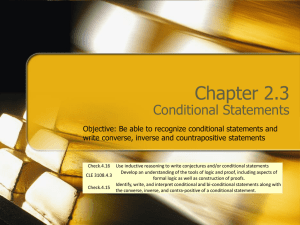Geo 2.1 - Robert Fant
advertisement
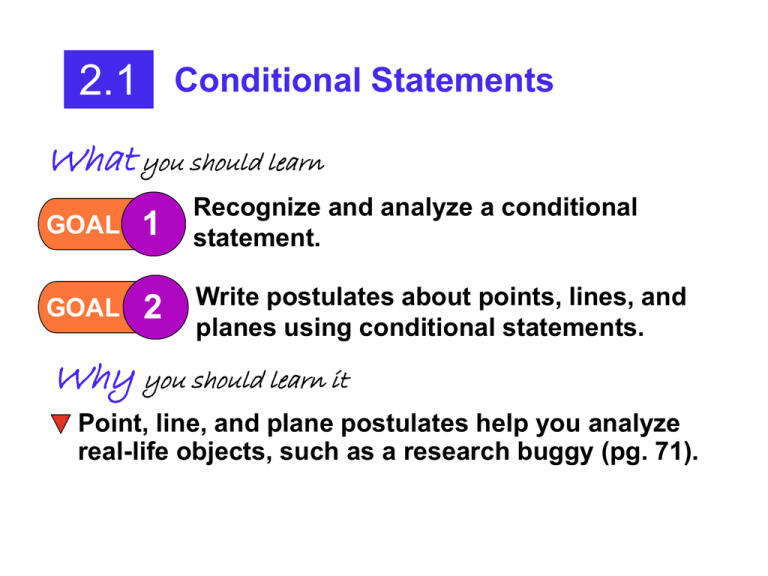
2.1 Conditional Statements What you should learn GOAL 1 Recognize and analyze a conditional statement. GOAL 2 Write postulates about points, lines, and planes using conditional statements. Why you should learn it Point, line, and plane postulates help you analyze real-life objects, such as a research buggy (pg. 71). 2.1 Conditional Statements GOAL 1 RECOGNIZING CONDITIONAL STATEMENTS VOCABULARY hypothesis A conditional statement has two parts, a __________ conclusion If the statement is written in if-then and a __________. form, the “if” part contains the __________ hypothesis and the “then” part contains the __________. conclusion If HYPOTHESIS, then CONCLUSION. EXAMPLE 1 Extra Example 1 Rewrite in if-then form: All mammals breathe oxygen. Hypothesis: Conclusion: An animal is a mammal. It breathes oxygen. If-then form: If an animal is a mammal, then it breathes oxygen. TRUE OR FALSE? For a conditional statement to be TRUE, the conclusion must be true for all cases that fulfill the hypothesis. It will be YOUR JOB to show this. For a conditional statement to be FALSE, only one counterexample is necessary. EXAMPLE 2 Extra Example 2 Write a counterexample: If a number is odd, then it is divisible by 3. Sample answer: 7 is odd and 7 is not divisible by 3. • Converse: The hypothesis and conclusion are switched. EXAMPLE 3 NEGATIONS Inverse: Both hypothesis and conclusion are negated. Contrapositive: The hypothesis and conclusion of a converse are negated. CAUTION: When writing negations, do not be more specific than the original statement. The negation of “It is raining” is “It is not raining,” NOT “It is sunny.” (It could be night, foggy, etc.). EQUIVALENT STATEMENTS • Two statements are either both true or both false. • A conditional is equivalent to its contrapositive, and the inverse and converse of any conditional statement are equivalent. EXAMPLE 4 Extra Example 4 Write the a) inverse, b) converse, and c) contrapositive of the statement. If the amount of available food increases, the deer population increases. Hint: Identify the hypothesis and conclusion first. Inverse: If the amount of available food does not increase, the deer population does not increase. Converse: If the deer population increases, the amount of available food increases. Contrapositive: If the deer population does not increase, the amount of available food does not increase. Checkpoint 1. Rewrite in if-then form: All monkeys have tails. If an animal is a monkey, then it has a tail. 2. Write a counterexample: If a number is divisible by 2, then it is divisible by 4. Sample: 14 is divisible by 2 but not divisible by 4. 3. Write the inverse, converse, and contrapositive of the statement: If an animal is a fish, then it can swim. Inverse: If an animal is not a fish, then it cannot swim. Converse: If an animal can swim, then it is a fish. Contrapositive: If an animal cannot swim, then it is not a fish. 2.1 Conditional Statements GOAL 2 USING POINT, LINE, AND PLANE POSTULATES Study the postulates on page 73, and be sure you understand what they mean. Example 5 will help you. EXAMPLE 5 Extra Example 5 Give examples of Postulates 5-11. P5: There is exactly one line (m) through A and B. P6: m contains at least two points (A and B). P7: m and n intersect at C. P8: Q passes through A, B, and D. P9: Q contains at least A, B, and D. P P10: A and B lie in Q. So m, which contains A and B, also lies in Q. P11: P and Q intersect in line n. D C A m EXAMPLE 6 n B Q Extra Example 6 Rewrite Postulate 6 in if-then form, then write its inverse, converse, and contrapositive. If-then form: If a figure is a line, then it contains at least two points. Inverse: If a figure is not a line, then it does not contain at least two points. Converse: If a figure contains at least two points, then it is a line. Contrapositive: If a figure does not contain at least two points, then it is not a line. EXAMPLE 7 Extra Example 7 Decide if the statement is true or false. If it is false, give a counterexample. Three points are always contained in a line. FALSE Sample answer: C B A Checkpoint 1. Write the inverse, converse, and contrapositive of Postulate 8. Inverse: If three noncollinear points are not distinct, then it is not true that there is exactly one plane that passes through them. Converse: If exactly one plane passes through three noncollinear points, then the three points are distinct. Contrapositive: If it is not true that exactly one plane passes through three noncollinear points, then the three points are not distinct. 2. Decide whether the statement is true or false. If it is false, give a counterexample. A line can contain more than two points. TRUE Vocabulary Check • • • • • • • • • Conditional Statement If-then form Hypothesis Conclusion Converse Inverse Contrapositive Negation Equivalent Statements
